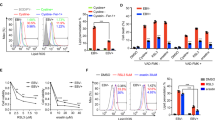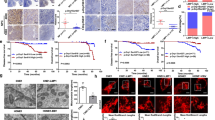Abstract
Nasopharyngeal carcinoma is closely associated with Epstein–Barr virus (EBV) infection. The EBV-encoded LMP1 has cell transformation property. It suppresses cellular senescence and enhances cell survival in various cell types. Many of the downstream events of LMP1 expression are mediated through its ability to activate NF-κB. In this study, we report a novel function of LMP1 to induce Id1 expression in nasopharyngeal epithelial cells (NP69) and human embryonal kidney cells (HEK293). The Id1 is a basic helix–loop–helix (bHLH) protein and a negative transcriptional regulator of p16INK4a. Expression of Id1 facilitates cellular immortalization and stimulates cell proliferation. With the combination of both specific chemical inhibitors and genetic inhibitors of cell signaling, we showed that induction of Id1 by LMP1 was dependent on its NF-κB activation domain at the carboxy-terminal region, CTAR1 and CTAR2. Induction of Id1 by LMP1 may facilitate clonal expansion of premalignant nasopharyngeal epithelial cells infected with EBV and may promote their malignant transformation.
This is a preview of subscription content, access via your institution
Access options
Subscribe to this journal
Receive 50 print issues and online access
$259.00 per year
only $5.18 per issue
Buy this article
- Purchase on Springer Link
- Instant access to full article PDF
Prices may be subject to local taxes which are calculated during checkout




Similar content being viewed by others
Abbreviations
- NPC:
-
nasopharyngeal carcinoma
- EBV:
-
Epstein–Barr virus
- LMP1:
-
latent membrane protein 1
- Id:
-
inhibition of DNA binding or differentiation
- NF-κB:
-
nuclear factor κB
- IκBα:
-
inhibitor of κB alpha
- FBS:
-
fetal bovine serum
References
Alani RM, Hasskarl J, Grace M, Hernandez MC, Israel MA and Munger K . (1999). Proc. Natl. Acad. Sci. USA, 96, 9637–9641.
Beg AA, Ruben SM, Scheinman RI, Haskill S, Rosen CA and Baldwin Jr AS . (1992). Genes Dev., 6, 1899–1913.
Blake SM, Eliopoulos AG, Dawson CW and Young LS . (2001). Virology, 282, 278–287.
Cahir-Mcfarland ED, Davidson DM, Schauer SL, Duong J and Kieff E . (2000). Proc. Natl. Acad. Sci. USA, 97, 6055–6060.
Cheung ST, Leung SF, Lo KW, Chiu KW, Tam JS, Fok TF, Johnson PJ, Lee JC and Huang DP . (1998). Int. J. Cancer, 76, 399–406.
Cowley S, Paterson H, Kemp P and Marshall CJ . (1994). Cell, 77, 841–852.
Dawson CW, Rickinson AB and Young LS . (1990). Nature, 344, 777–780.
Dawson CW, Tramountanis G, Eliopoulos AG and Young LS . (2003). J. Biol. Chem., 278, 3694–3704.
DiDonato JA, Hayakawa M, Rothwarf DM, Zandi E and Karin M . (1997). Nature, 388, 548–554.
Eliopoulos AG and Young LS . (2001). Semin. Cancer Biol., 11, 435–444.
Eliopoulos AG, Blake SM, Floettmann JE, Rowe M and Young LS . (1999). J. Virol., 73, 1023–1035.
Fahraeus R, Fu HL, Ernberg I, Finke J, Rowe M, Klein G, Falk K, Nilsson E, Yadav M and Busson P . (1988). Int. J. Cancer, 42, 329–338.
Fielding CA, Sandvej K, Mehl A, Brennan P, Jones M and Rowe M . (2001). J. Virol., 75, 9129–9141.
Hammerschmidt W, Sugden B and Baichwal VR . (1989). J. Virol., 63, 2469–2475.
Hatzivassiliou E and Mosialos G . (2002). Front. Biosci., 7, D319–D329.
Jeannel D, Bouvier G and Huber A . (1999). Cancer Surv., 33, 125–155.
Kaye KM, Izumi KM and Kieff E . (1993). Proc. Natl. Acad. Sci. USA, 90, 9150–9154.
Ling MT, Wang X, Ouyang XS, Lee TK, Fan TY, Xu K, Tsao SW and Wong YC . (2002). Oncogene, 21, 8498–8505.
Lo AK, Liu Y, Wang X, Huang DP, Yuen PW, Wong YC and Tsao SW . (2003). Lab. Invest., 83, 1–13.
Nehlin JO, Hara E, Kuo WL, Collins C and Campisi J . (1997). Biochem. Biophys. Res. Commun., 231, 628–634.
Ohtani N, Brennan P, Gaubatz S, Sanij E, Hertzog P, Wolvetang E, Ghysdael J, Rowe M and Hara E . (2003). J. Cell Biol., 162, 173–183.
Ohtani N, Zebedee Z, Huot TJ, Stinson JA, Sugimoto M, Ohashi Y, Sharrocks AD, Peters G and Hara E . (2001). Nature, 409, 1067–1070.
Pathmanathan R, Prasad U, Sadler R, Flynn K and Raab-Traub N . (1995). N. Engl. J. Med., 333, 693–698.
Pierce JW, Schoenleber R, Jesmok G, Best J, Moore SA, Collins T and Gerritsen ME . (1997). J. Biol. Chem., 272, 21096–21103.
Quandt K, Frech K, Karas H, Wingender E and Werner T . (1995). Nucleic Acids Res., 23, 4878–4884.
Raab-Traub N . (2002). Semin. Cancer Biol., 12, 431–441.
Sanchez I, Hughes RT, Mayer BJ, Yee K, Woodgett JR, Avruch J, Kyriakis JM and Zon LI . (1994). Nature, 372, 794–798.
Sham JS, Choy D and Wei WI . (1990). Int. J. Radiat. Oncol. Biol. Phys., 19, 929–933.
Sikder HA, Devlin MK, Dunlap S, Ryu B and Alani RM . (2003). Cancer Cell, 3, 525–530.
Tsao SW, Tramoutanis G, Dawson CW, Lo AK and Huang DP . (2002a). Semin. Cancer Biol., 12, 473–487.
Tsao SW, Wang X, Liu Y, Cheung YC, Feng H, Zheng Z, Wong N, Yuen PW, Lo AK, Wong YC and Huang DP . (2002b). Biochim. Biophys. Acta, 1590, 150–158.
Wang D, Liebowitz D and Kieff E . (1985). Cell, 43, 831–840.
Wang X, Jin DY, Wong HL, Feng H, Wong YC and Tsao SW . (2003). Oncogene, 22, 109–116.
Wang X, Xu K, Ling MT, Wong YC, Feng HC, Nicholls J and Tsao SW . (2002). Mol. Carcinogen., 35, 42–49.
Yang XH, Sham JST, Ng MH, Tsao SW, Zhang DK, Lowe SC and Cao L . (2000). J. Virol., 74, 883–891.
Zabel U, Schreck R and Baeuerle PA . (1991). J. Biol. Chem., 266, 252–260.
Acknowledgements
We are grateful to Dr Zhenguo Wu at Hong Kong University of Science and Technology for providing PD098059, Dr Leonard I. Zon at Harvard Medical School for providing pEBG SEK (KR), and Dr Michael Karin at University of California-San Diego for providing HA-IKKα. This project was supported by the Research Grant Council, Hong Kong (HKU7356/02M) and a research retreat grant (Faculty of Medicine, the University of Hong Kong).
Author information
Authors and Affiliations
Corresponding author
Rights and permissions
About this article
Cite this article
Li, H., Zhuang, Z., Wang, Q. et al. Epstein–Barr virus latent membrane protein 1 (LMP1) upregulates Id1 expression in nasopharyngeal epithelial cells. Oncogene 23, 4488–4494 (2004). https://doi.org/10.1038/sj.onc.1207580
Received:
Revised:
Accepted:
Published:
Issue Date:
DOI: https://doi.org/10.1038/sj.onc.1207580
Keywords
This article is cited by
-
An update on viral association of human cancers
Archives of Virology (2013)
-
MiR-663, a microRNA targeting p21WAF1/CIP1, promotes the proliferation and tumorigenesis of nasopharyngeal carcinoma
Oncogene (2012)
-
Epstein-Barr virus encoded latent membrane protein 1 regulates mTOR signaling pathway genes which predict poor prognosis of nasopharyngeal carcinoma
Journal of Translational Medicine (2010)
-
Aberrant Expression of ID2 protein and its correlation with EBV-LMP1 and P16(INK4A) in Classical Hodgkin Lymphoma in China
BMC Cancer (2008)
-
Latent membrane protein 1 suppresses RASSF1A expression, disrupts microtubule structures and induces chromosomal aberrations in human epithelial cells
Oncogene (2007)



